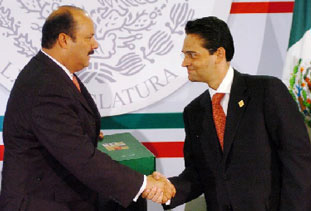
|  |  |  Editorials | Issues | September 2008 Editorials | Issues | September 2008  
The Mexican Informe Presidencial – A Changing Tradition
 Allan Wall - PVNN Allan Wall - PVNN


| | Interior Secretary Juan Camilo Mouriño Terrazo (R) delivers document containing Second State of the Union Report to Congress. (Presidencia de la República) | | |
On September 1st, 2008, Mexican Interior Secretary Juan Camilo Mouriño arrived at the Mexican congressional building and, in a brief (eight minute) ceremony, delivered a document from the President of Mexico to the Mexican Speaker of the House.

This document was the Informe Presidencial, Mexico's equivalent of our own State of the Union Address. In Mexico, however, the tradition is changing. It’s a long story.

The U.S. Constitution stipulates that the president "shall from time to time give to Congress information of the State of the Union and recommend to their Consideration such measures as he shall judge necessary and expedient" (Article II, Section 3). Under President George Washington this became a formal speech to Congress.

Like many of our political traditions, this custom was modeled after a British tradition, in this case the "Speech from the Throne," part of the annual Opening of Parliament ceremony.

In Mexico, the 1917 Constitution required the president to deliver an "Informe Presidencial."

In the old days, when the PRI (Institutional Revolutionary Party) ran a one-party state government, the Informe was not complicated. Why would it have been? The same party controlled the executive, legislative, and judicial branches of government.

In those days, the president of Mexico would use the Informe as a propaganda platform to announce policies. In 1982, President Jose Lopez Portillo, who only had 3 months to go as chief executive, utilized the Informe to announce the nationalization of Mexico’s banking system. The nationalization turned out to be a disaster, but that’s another story….

A couple of decades ago, the Informe changed from being a ritualized formality to being a bone of contention and scene of conflict. After the acrimonious election of 1988, opposition politicians began to use the Informe as an opportunity to protest. Given the media attention accorded to the annual ritual, that strategy was an effective manner of garnering attention. So from time to time there were protests at the Informe. But no matter what happened, the speech itself continued to be delivered.

That changed in 2006, after Felipe Calderon was elected but before he took office. The PRD (Party of the Democratic Revolution), still smarting over its narrow defeat in the 2006 election, took control of the dais in the legislative chamber to prevent President Vicente Fox from entering and speaking. So Fox showed up in the lobby, delivered the written text of his speech and left. Technically speaking, this was legally acceptable. Article 69 of the Mexican Constitution, the legal basis for the Informe, only required the president to deliver a "written report." So Fox had discharged his constitutional duty.

Last year the congressional dais was again taken over by opposition legislators. Calderon couldn’t make it to the top of the platform, so he just left the written text of the Informe.

Now, articles 69 and 93 of the Mexican Constitution have been amended, and it’s no longer necessary for the president to personally deliver the document. The whole tradition has been scaled down. That’s a good thing, because it had become a veritable circus of political posturing and a waste of time. Now it’s just the delivery of a document to Congress, and the opposition parties can respond as they wish.

So this year, Interior Secretary Mouriño delivered the Informe on behalf of the president. In a ceremony only lasting 8 minutes, Mouriño delivered the 524-page document to Cesar Horacio Duarte, the PRI Speaker of the House.

Unsurprisingly, this year’s Informe, as always, presented things from the president´s point of view.

The Calderon administration took credit for keeping food prices down. Yes, they have risen, but the spin is they would be higher without Calderon’s efforts.

Mexico’s inflation rate has reached 5.39%, but, says the president, it’s still low for Latin America.

President Calderon also claims to be making progress in Mexico's war against the drug cartels, stating that "The federal government has acted firmly and decisively to strengthen the rule of law and guarantee public security."

Opposition politicians of course dispute Calderon’s claims, which is also unsurprising.

Of course both sides will spin things to their own advantage. What do you expect?

That’s the way it works in our country too. That’s why, since 1966, television rebuttals of the State of the Union have been broadcast following the president's address.

It’s called politics.
 Allan Wall is an American citizen who has been teaching English in Mexico since 1991, and writing articles about various aspects of Mexico and Mexican society for the past decade. Some of these articles are about Mexico's political scene, history and culture, tourism, and Mexican emigration as viewed from south of the border, which you can read on his website at AllanWall.net. Allan Wall is an American citizen who has been teaching English in Mexico since 1991, and writing articles about various aspects of Mexico and Mexican society for the past decade. Some of these articles are about Mexico's political scene, history and culture, tourism, and Mexican emigration as viewed from south of the border, which you can read on his website at AllanWall.net.

Click HERE for more articles by Allan Wall. |

 |
|  |



